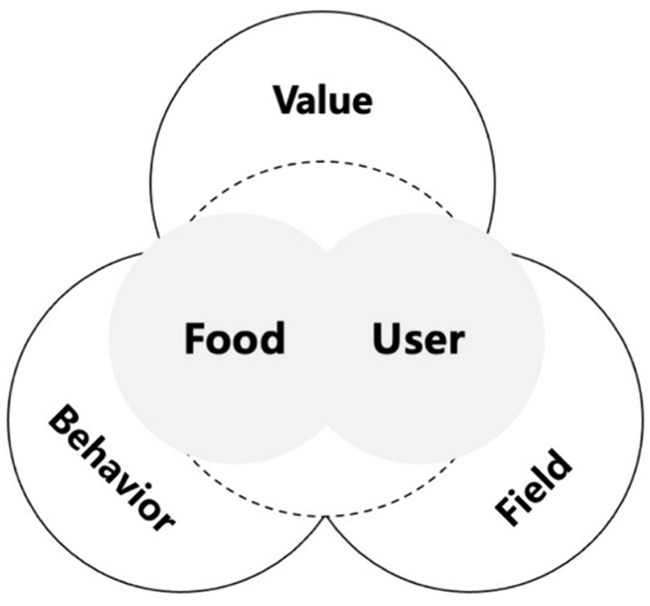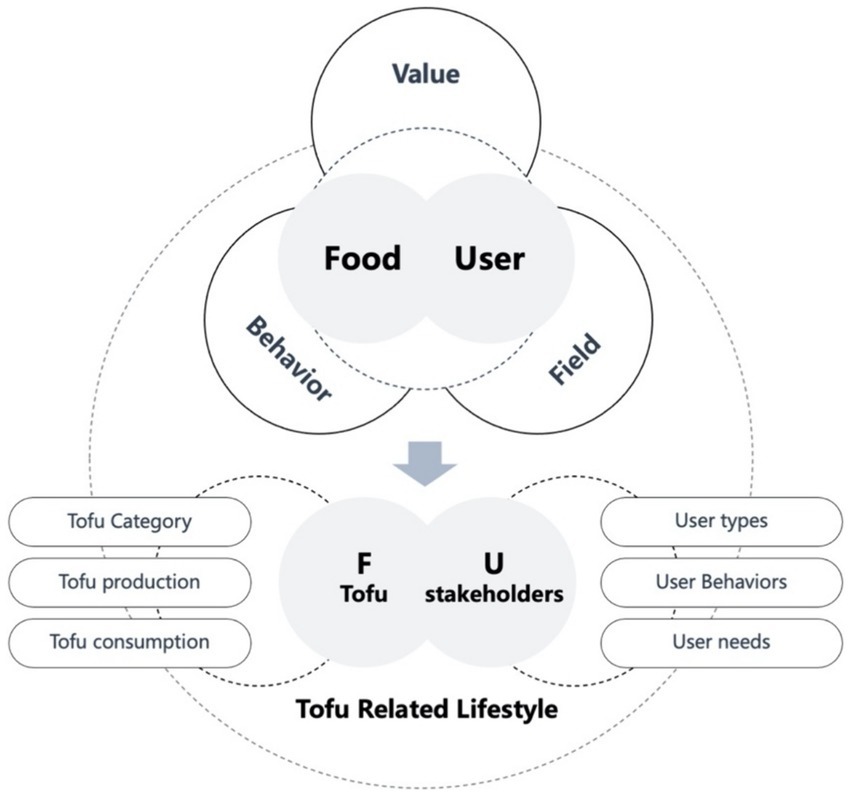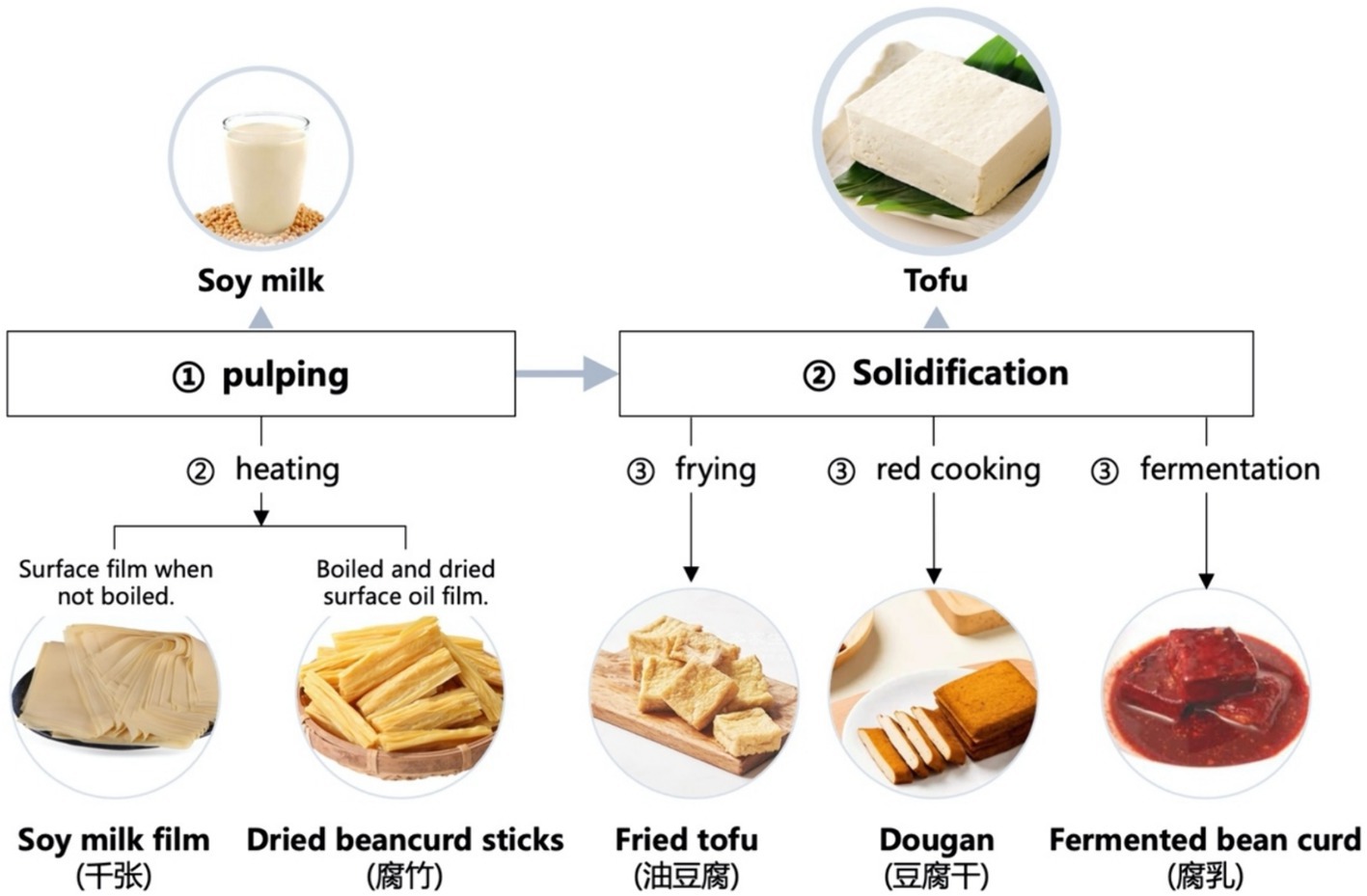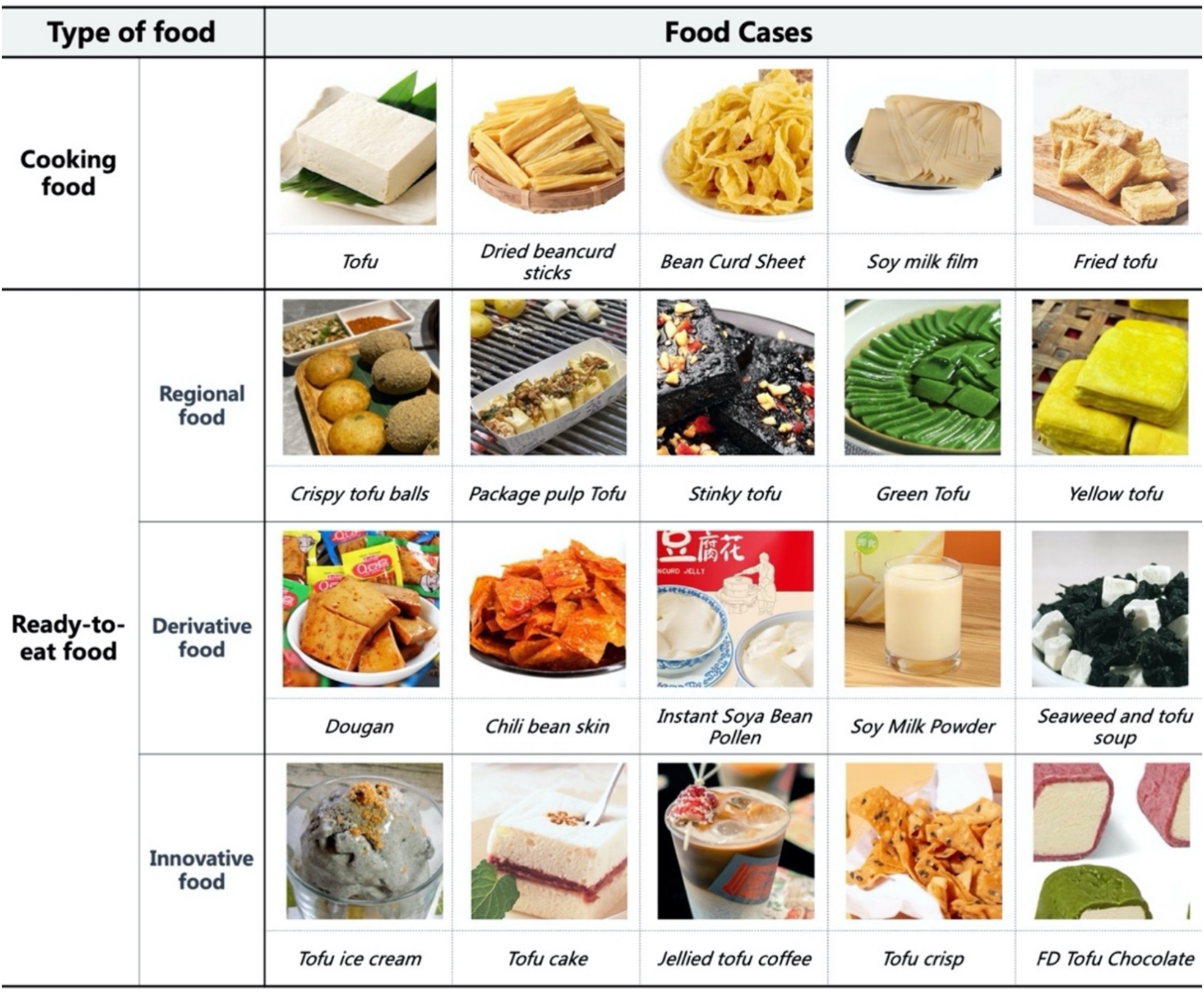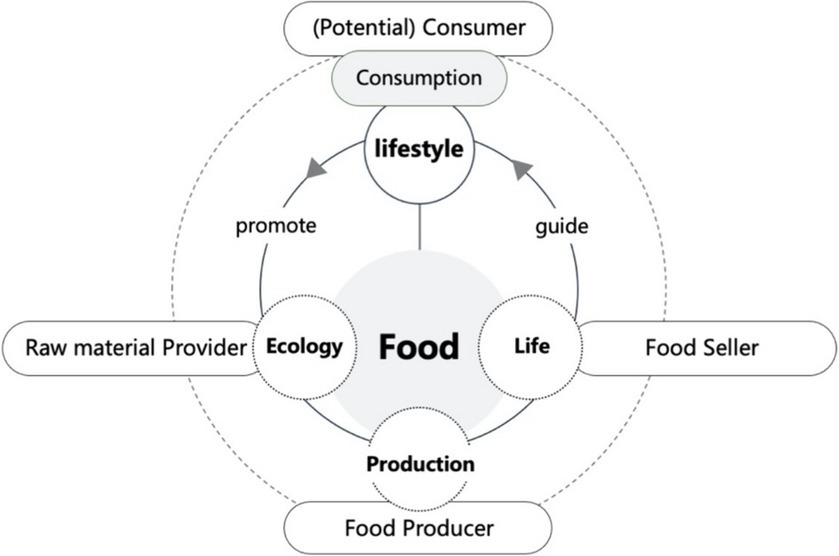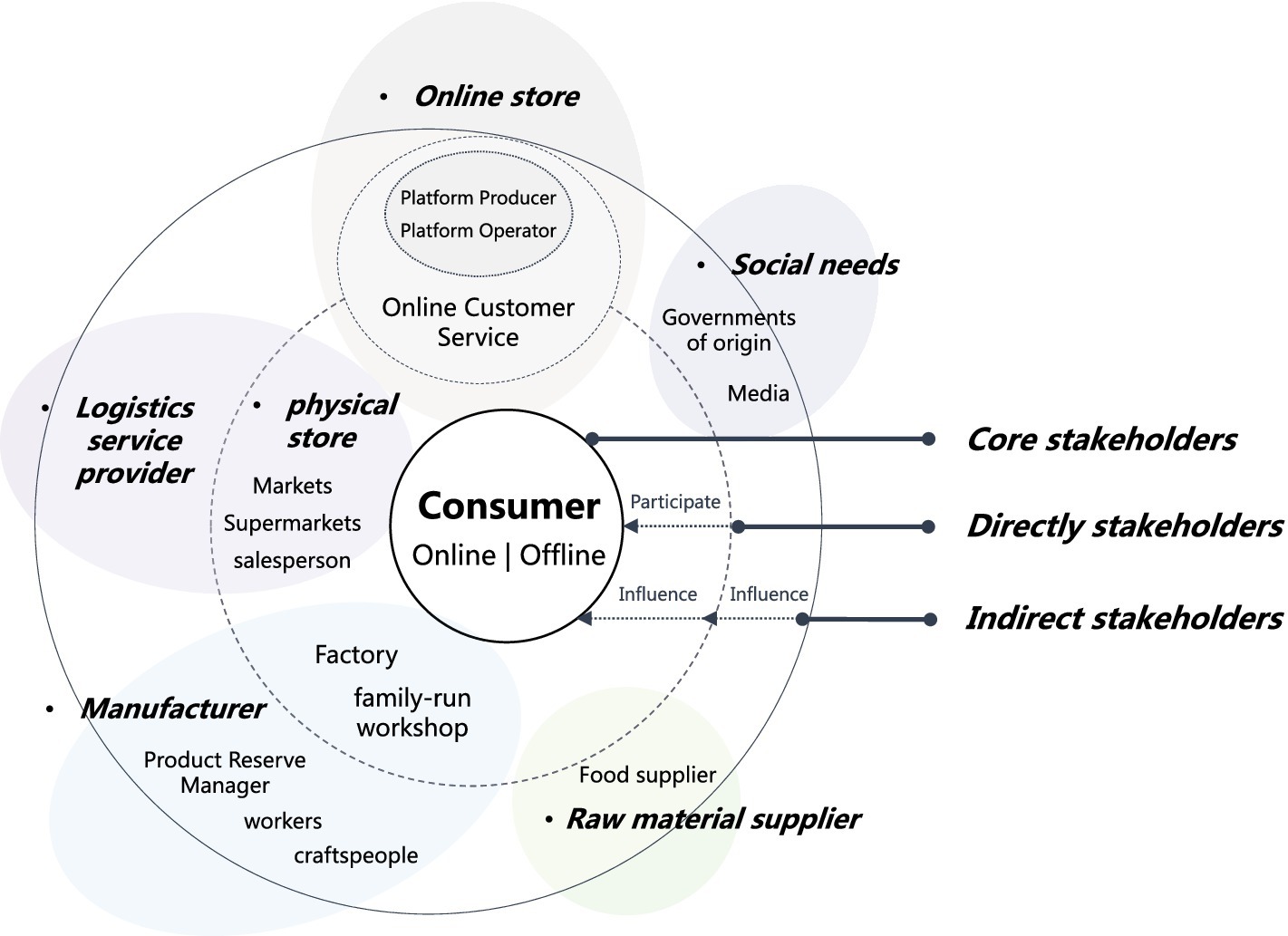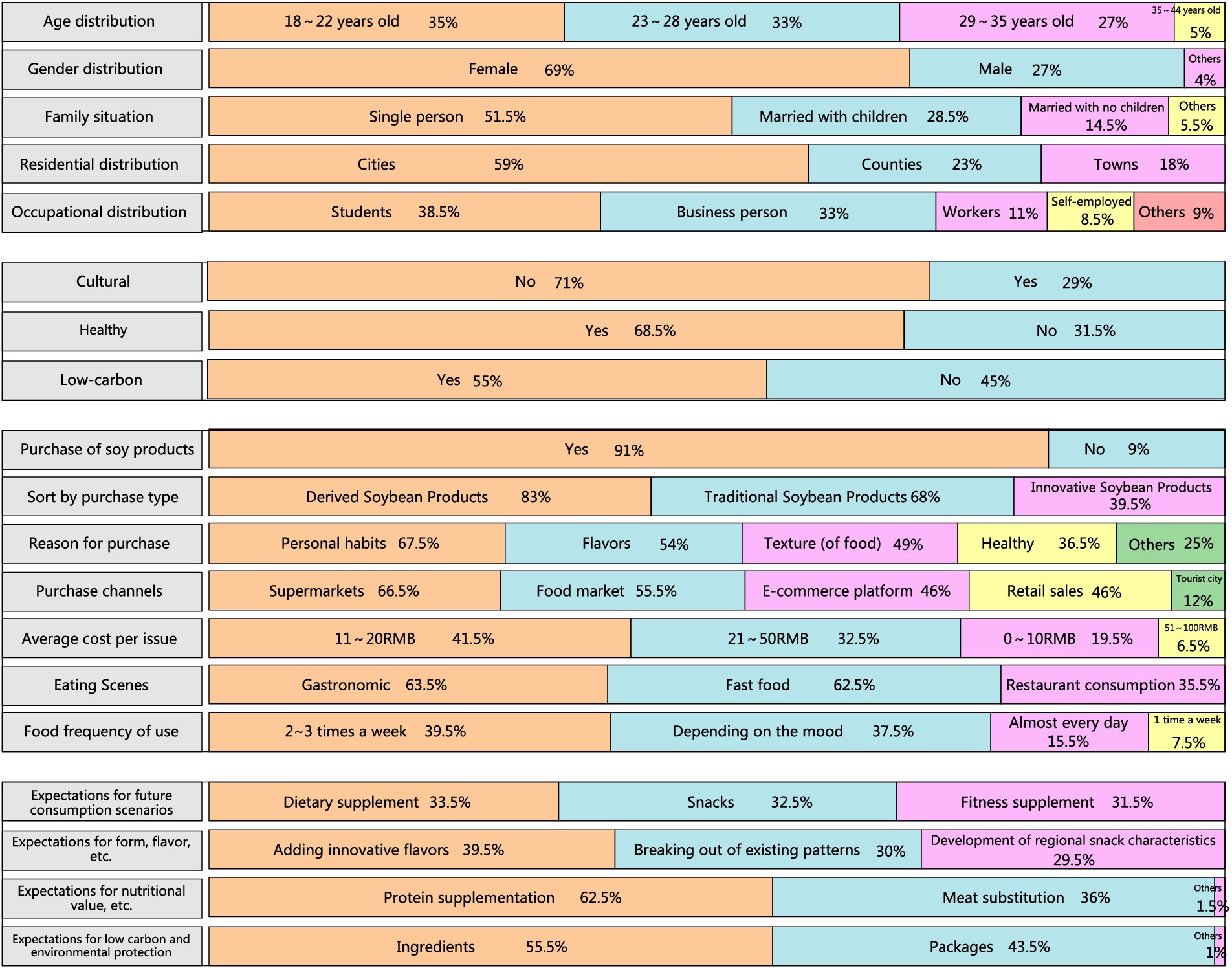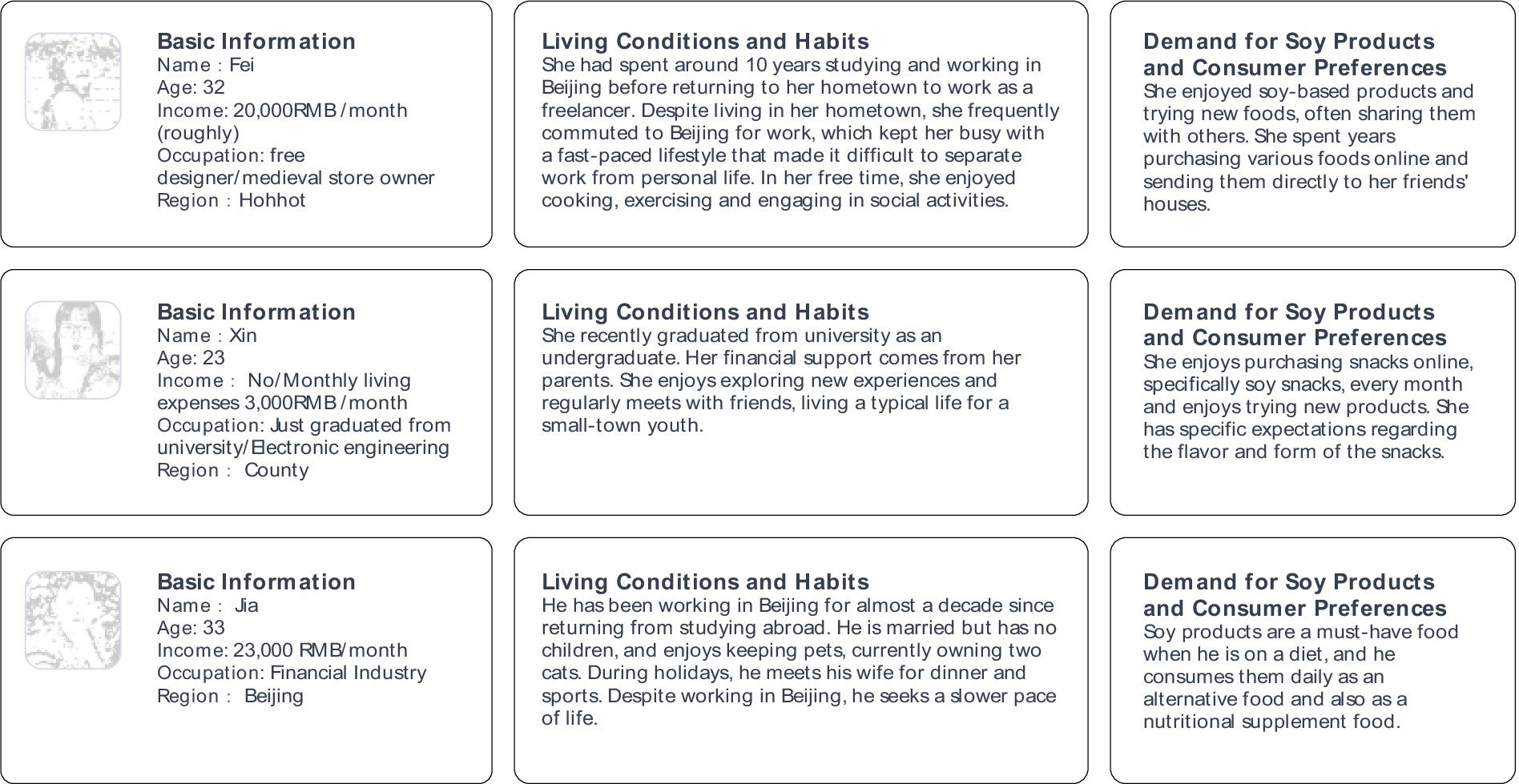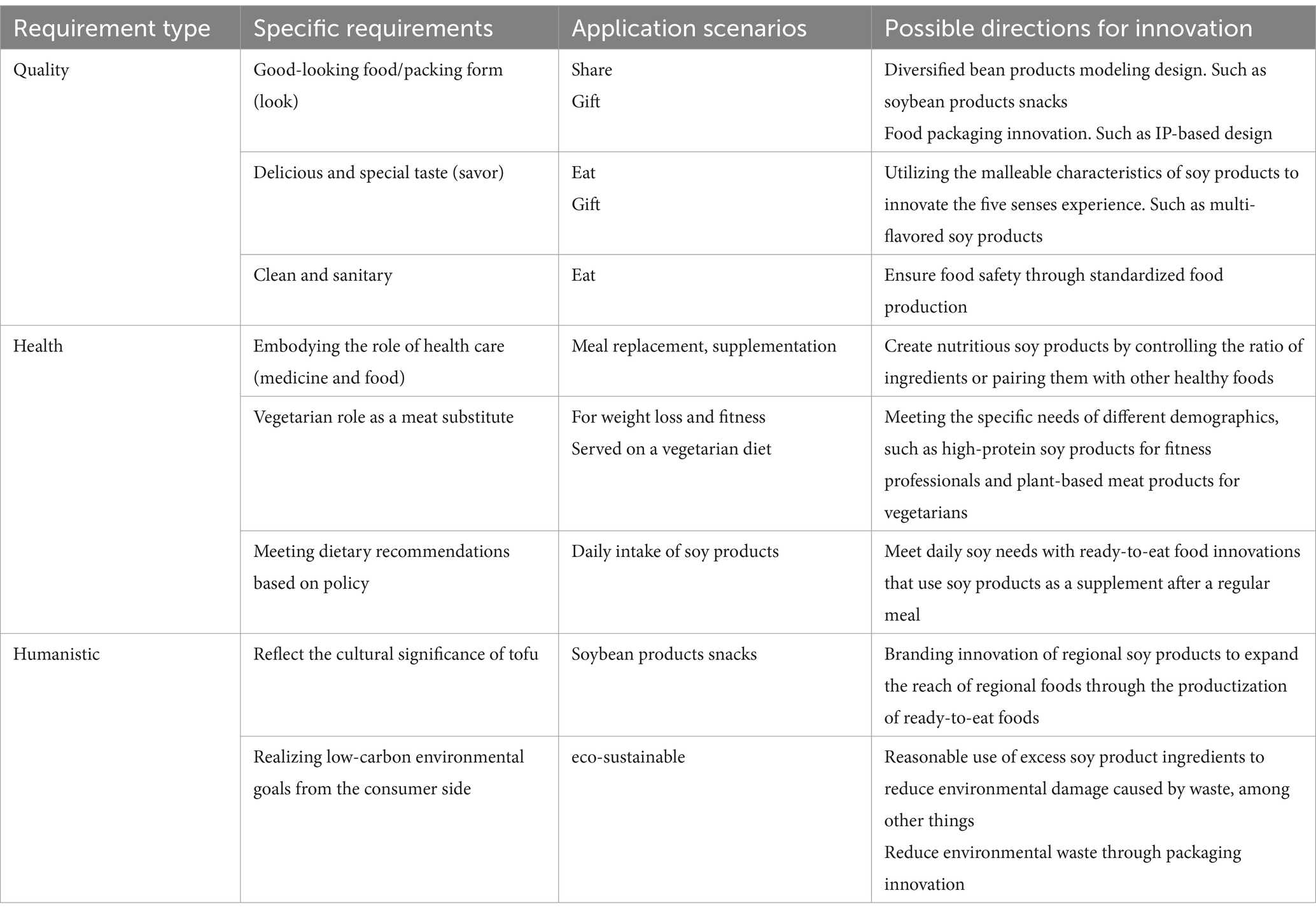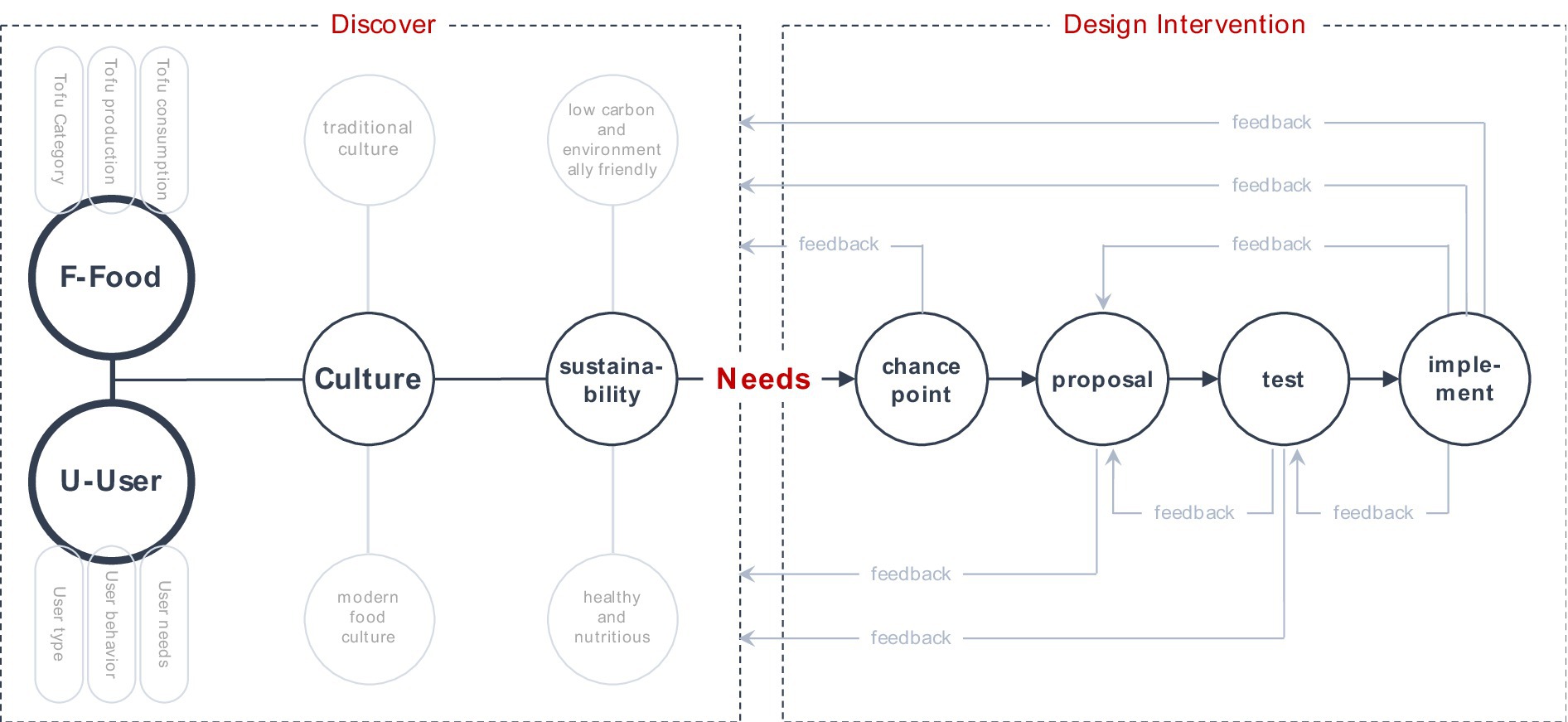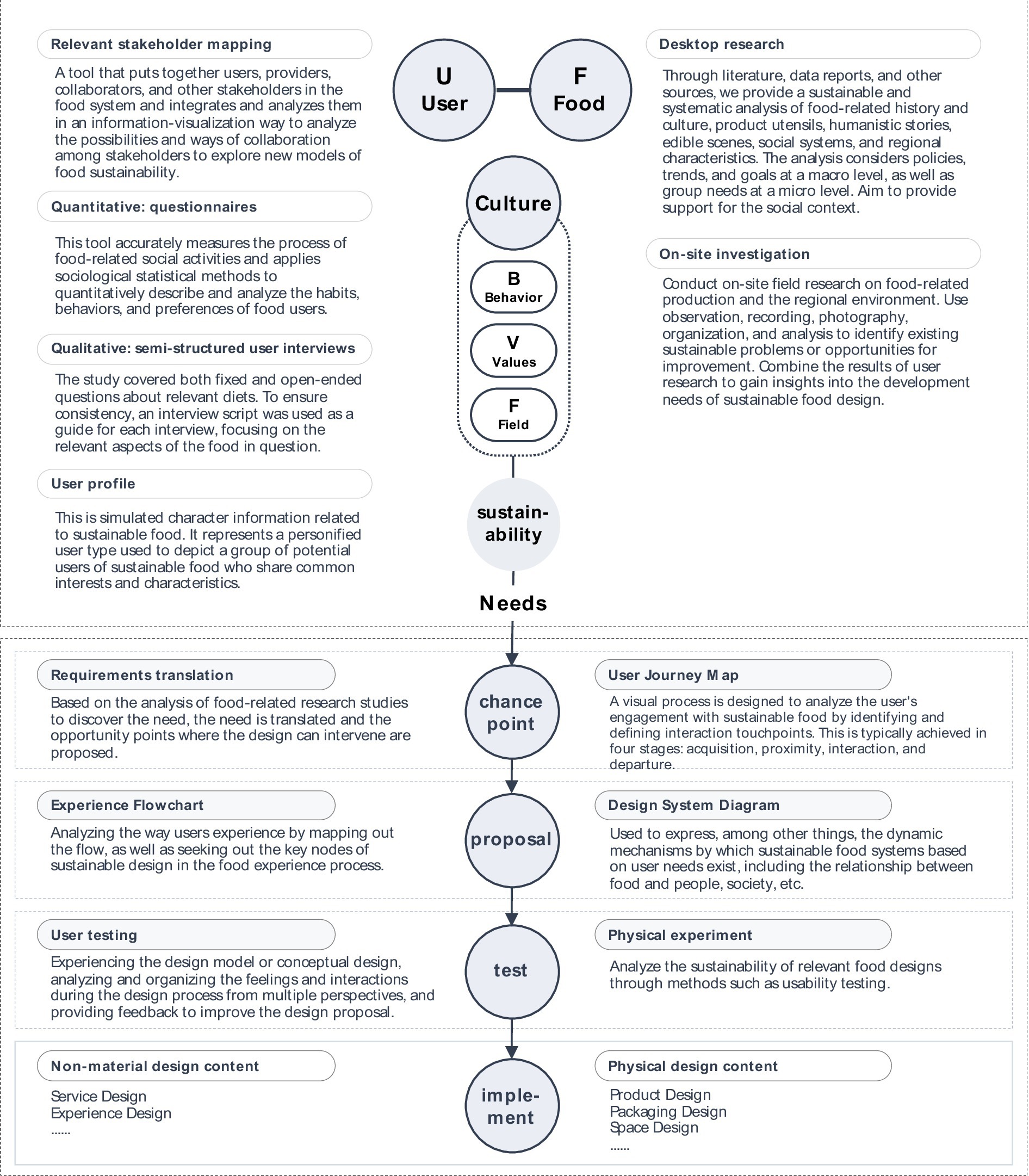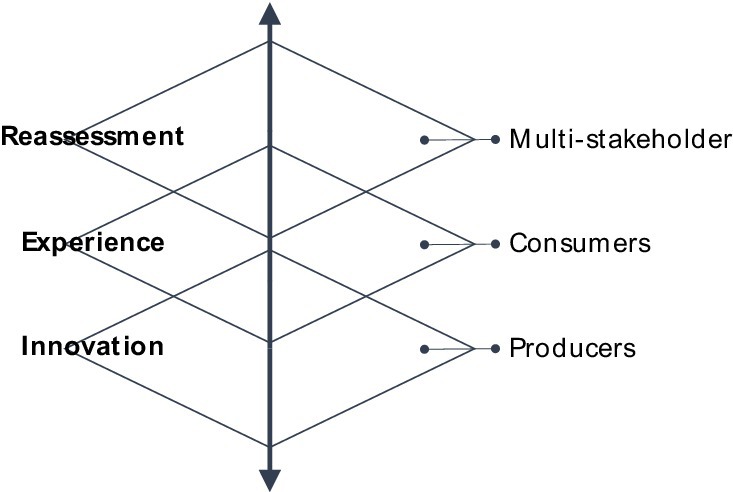- Department of Spatial Culture Design, Graduate School of Techno Design, Kookmin University, Seoul, Republic of Korea
The food lifestyle has evolved from the regional differences that were previously shaped by different geographic locations to the pluralistic complexity of food styles that are now influenced by different user consciousnesses. The field of food design has assumed a greater social responsibility, while also facing the challenge of sustainable development. Consequently, it is of paramount importance to devise or refine the methodology of food design innovation. This study makes a significant contribution to the field of sustainable food design by combining design methodology with sociological concepts such as “Field and Habitus” to construct the “F-U-BVF” food lifestyle analysis framework. This study examines the applicability of the F-U-BVF analytical framework, exemplified by tofu, through the refinement and translation of user needs, among other methods. The objective is to guide users toward sustainable lifestyles based on a design methodology, thereby creating multiple values conducive to food sustainability. At the same time, the deconstruction of the structural relationship, process, and methodology of sustainable food design based on the F-U-BVF analytical framework is intended to break through the barriers of traditional design science. This is to provide a new systematic research paradigm for sustainable food design, as well as to provide a new perspective on the experience and interactive relationship between people and food. Finally, it is also to provide effective food design innovation solutions for relevant multi-stakeholders. This is of great significance for the development of sustainable food design.
1 Introduction
The process of socio-economic transition from an agro-pastoral economy to an industrial economy to a service economy (Liang et al., 2022), with the globalization of information, environmental changes and cultural developments, has led to complex problems and challenges in society, resulting in group needs and conflicts between people in the spatial environment. To address the current social problems and challenges of environmental degradation, social inequality and economic instability faced globally, it is necessary to embrace the principles of sustainalism and adopting a sustainalist lifestyle, pave the way toward a more sustainable economy that balances humanity’s and the environment’s needs, benefiting everyone involved (Hariram et al., 2023). In this regard, Governments are setting or have set targets for change and are taking sustainable action, including innovation in policies, services, products, etc., to address the challenges (Elzen and Wieczorek, 2005; Almeida et al., 2013; Silvestre and Ţîrcă, 2019). This shift in focus not only promotes the development of design solutions for social problems but also expands the scope of design beyond physical objects to include non-object design such as service design, information design, and lifestyle design (Liang et al., 2022). This change is closely linked to the shift in the social characteristics of modern humans, and it gives design the ability and social responsibility to promote change. Design should be utilized as a strategic tool to promote sustainable innovation and play a crucial role in integrating transformative capacity and social responsibility. Sustainable design takes into account the environmental, economic and social impacts that occur throughout a product’s life cycle (Elkington, 1997). It involves rethinking modern society’s way of life and aims to create design changes for products and services that minimize resource consumption and promote recycling. With the development of society and the awakening of people’s sense of social responsibility, today’s ecological environment and social issues have prompted designers to pay attention to the concept of sustainable development and changes in the way of life (Papanek, 2020). As a result, there are numerous initiatives aimed at promoting sustainable behavior and innovation through design. Design innovation has become a key driver of sustainable change (Chick and Micklethwaite, 2011; Keitsch, 2012).
Food is a crucial source of energy for human beings in their daily activities and is closely linked to global issues and sustainable development (Rasul, 2016). Modern technologies, such as preservation methods, and the rapid development of the transportation industry have made food a commodity. The focus on profit, rather than health, has become the primary goal of the food industry (Zhang, 2000). But food is much more than a commodity. Food has a significant impact on human and environmental health, and sustainable diets can be a win-win for both human health and environmental sustainability (Zhang and Chai, 2022; Liu et al., 2024). The wastage and pollution involved in the life cycle of food, including raw materials, production, sale, consumption, disposal, and recycling, have a direct or indirect impact on ecological and environmental sustainability (Murphy et al., 2014; Nemecek et al., 2016; Lekavičius et al., 2023). At the same time, the regional cultural variability carried by food also reflects the different social patterns between regions from the side, clearly defining the relationship between the regional system context and its food (Hinrichs, 2003; Kittler et al., 2016). Additionally, many consumers hold the belief that plant-based diets are healthier than animal-based diets. This belief has led to changes in dietary behaviors (Possidónio et al., 2021) and has continued to encourage the development of sustainable dietary lifestyles. As a result, the concept of “sustainable diets” has emerged as a paradigm that considers both the ecological aspects of specific environments and human health and nutrition. It also focuses on the affordability and sociocultural acceptability of diets at global, local, and individual levels (Garnett et al., 2014; Johnston et al., 2014; del Valle et al., 2022).
The Food and Agriculture Organization of the United Nations (FAO) recognizes sustainable diets as dietary patterns that promote an individual’s health and well-being, have low environmental impact, and are accessible, affordable, safe, equitable, and culturally acceptable (Food and Agriculture Organization of the United Nations, 2020). Food involves ecology, society, economy, health, culture, and their interrelationships, which together constitute the macro-organization of sustainable food (Hajer et al., 2016; Mason and Lang, 2017). The design intervention in sustainable food development is a balanced optimization of the relationship between these factors. At the same time, consumer food choices are shaped by the food environment, including access to healthy foods (Turner et al., 2021). Therefore, the intervention of design prompts the supply side, processors, and others to rethink the possibility of food sustainability (Sijtsema and Snoek, 2023) and explore how to provide more effective and innovative ideas and strategies for structural changes in food development. This becomes a real challenge for the sustainable design of food. For instance, Grönman et al. used different methods at different stages of food packaging design to improve the sustainability of the packaging, integrating sustainability into the design process at all stages (Grönman et al., 2013). Choi and Blevis investigated the impact of human-computer interaction (HCI) design on promoting individual participation in establishing a sustainable food culture in urban areas (Choi and Blevis, 2010). Clear et al. conducted a detailed microdocumentation of participants to quantify the relationship between potential impacts and their daily food preparation methods, scheduling, and roles in social gatherings. The aim was to inform the sustainable design of at-home cooking and dining (Clear et al., 2013). These studies show that sustainable innovation research and practice in food has expanded beyond its original limitations with the design shift. There is now more consideration given to combining bottom-up consumer social responsibility awareness with top-down design strategy interventions. In other words, sustainable food design emerges from a combination of user awareness of responsibility and producer product innovation (Nielsen et al., 2016). This paper argues that sustainable design is one of the ways to define the connotations and forms of food design and create points of connection between relevant variables such as people and food, thus making design one of the innovative ways to make food sustainable. Therefore, research on “Food” and “User” is one of the requirements for sustainable food design before food innovations can be generated and related issues can be defined. The objective of this study is to cross-fertilize multiple disciplines from the perspectives of “food” and “user,” with the construction of dietary lifestyle research methodology serving as the primary innovation point for sustainable food design. This approach is intended to enhance the multifaceted values conducive to the sustainable development of food and to break through the barriers of traditional design science in order to provide a new systematic research paradigm for sustainable food design.
2 Methods and process
2.1 Constructing a methodology for studying dietary lifestyles
2.1.1 Field theory
The concept of “field (French champ) theory” was put forward by the renowned French sociologist Pierre Bourdieu (Hilgers and Mangez, 2014). This theory provides a crucial theoretical foundation for comprehending and analyzing lifestyles. The term “field” refers to the social space in which individuals are subject to certain rules and norms, as well as the specific social, economic, and cultural relationships that exist within that space. “Habitus” is another core concept in Bourdieu’s sociological theory (Bourdieu, 2009). It refers to the habits of perception, thought, and behavior that are accumulated and solidified through long periods of life practice and taken for granted. The cognitive structure of individuals as the subject of behavior is characterized by a perception mode formed through long-term social practice, known as the “Habitus.” The “Habitus” guides the generation of people’s thoughts and behaviors, and lifestyle is a complete and systematic expression of the products and behaviors of “Habitus” in a specific “field” (Bourdieu, 2014, 2020). Since the 20th century, behavioral economists have researched the types and components of lifestyle to provide a theoretical basis for understanding the consumption habits of different social groups. Recently, research on lifestyle has focused on the behavioral characteristics and consumption habits of various social groups (Xin, 2020).
2.1.2 Factors affecting modern dietary habits
According to the theory of “Field-Habitus,” the dietary practices of individuals within specific social, economic, and cultural contexts form a “Habitus” that influences their thoughts and behaviors related to food, ultimately shaping their dietary lifestyles.
User: The main factor influencing modern dietary lifestyles is the user. People are the primary agents in food production, selection, distribution, and other related activities. However, their behavior and realize are not fixed. They can change due to various external factors such as social, environmental, and economic conditions, as well as their backgrounds, emotions, and feelings. These factors play a significant role in the emergence and development of dietary lifestyles.
Field space: It is important to recognize that human beings are social creatures and that society often influences their actions. The society serves as a “field space” for actors, encompassing policies, economy, technology, culture, and other social layers that guide the development of dietary lifestyles. All behavioral activities within the field space have their bottom line, and although the development of dietary lifestyles relies on social influences, it is also influenced by “the choices and identities of people in the relevant social activities,” which results in the creation or development of diversified dietary lifestyles.
Behavior: People as a behavioral subject in the field of space generated by the “habitus “determines the dietary lifestyle, which mainly refers to the activities and habits generated by people, the activities determine the behavioral actions and social scope, attributes, etc., habit is the user’s long-term habitual activities generated by the behavioral preferences, which are the user’s physiological and psychological needs for food comprehensive reflection.
Value: The choice of dietary lifestyles among different groups is influenced by various factors, including personal values and their perceived impact on society (Zhang, 2008). This dimension is a key variable in the study of food-related cultural and social contexts, as well as in the psychological and spiritual aspects of food. Values can impact dietary behaviors and lifestyle choices. However, they can also change in response to human experiences. The function of values lies in their ability to encapsulate culturally significant concepts, connotations, sentiments, and convictions, which can then be utilized to motivate actions (Rokeach, 1973).
In summary, the user is central to shaping modern dietary lifestyles. Behavioral patterns, influenced by people’s activities and habits, are key factors in determining dietary lifestyles. Additionally, people’s values play a role in the formation of diverse dietary lifestyles, while the environment in which people live provides the background orientation for their dietary choices. The interplay of these factors creates a diverse and contemporary dietary lifestyle and also provides a benchmark for examining particular food and cultural practices.
2.1.3 Research methods for dietary lifestyles
The primary objective of constructing a research methodology for dietary lifestyles is to treat them as structured objects to be guided. The focus is on describing the state of people’s dietary lifestyles in a specific field environment, using their essential attributes and dimensional analysis as the main content. Currently, scholars typically study lifestyles using ethnography and phenomenological research methods. This involves user observation, interviews, and questionnaires, as well as extracting keywords, categorization, abstraction, and comparison. Researchers validate their findings through a reciprocal cycle of research until they develop a framework that can be applied beyond the limited empirical material and specific objects of observation while remaining relatively stable (Xin, 2020). Based on the analysis of the influencing factors of dietary lifestyle, this study constructs a research method of dietary lifestyle based on “field theory” from the perspective of food and the dimensions of users’ behaviors (habits, activities) and values in a specific field space, i.e., the research framework of “F-U-BVF (Food Food-User User Behavior, Value Values, Field Field)” (Figure 1). The objective is to interpret the eating lifestyle by incorporating the relevant perceptions, conceptual thinking, speculations, doubts, pleasures, pains, hopes, worries, desires, and demands (Ni, 2007) of users of eating activities into the empirical material.
The analysis of dietary lifestyle attributes and dimensions should be an objective evaluation based on the user’s perspective. The F-U-BVF framework’s dynamic research on users is analyzed from three perspectives. The first one is the field space, which includes both objective factors at the social level such as policy background, social culture, spatial environment, and people’s continuous relationship with other people or things in the social space. The second perspective is the value orientation, which consists of the value orientation at the time of the behavior or event and the intensity of the feelings in the heart and its continuous impact, which drives user behavior. Lastly, the third perspective is behavioral habits, which include daily living habits, eating habits, and other specific manifestations of food life. This analysis provides more reference value for multi-dynamic research on users and a more comprehensive approach to research on dietary lifestyles. The F-U-BVF research framework is employed in the field of food design innovation. This framework is utilized to analyze the complex relationship between food and users, the continuous influence on the social environment, and the user’s habits and activities in their dietary life. This analysis allows for the identification of potential design solutions that align with the needs and preferences of users. For instance, the F-U-BVF research framework can be employed to examine the application environments, user behavioral patterns, and prospective development dynamics of a diverse array of foods with sustainability characteristics, including alternative foods (plant proteins, insect proteins, etc.), surplus foods (coffee grounds, fruit peels, etc.), and so forth. Propose innovative possibilities from multiple perspectives, including food itself, related products, visual impressions, space, interactive behaviors, reflective activities, and so forth, with the objective of promoting the innovative development of related sustainable food design. It can be argued that the F-U-BVF research framework reflects the plasticity of the dietary lifestyle itself and, at the same time, interprets the diversity of life itself to guide the researcher to discover the different opportunities for the development of food from different dimensions and to establish the corresponding dietary lifestyle guidelines, to re-comprehend and adapt to different social environments, and to continuously update or adopt new dietary lifestyles.
2.2 Dietary lifestyle study using the example of Chinese tofu
Tofu has become a popular traditional food due to its nutritional value, soft texture, and versatility in preparation. Tofu has its origins in China and has since spread throughout East Asia and beyond as a result of social and cultural movements. The spread of tofu and soy products has provided the world with a resource of high-quality plant proteins, contributing significantly to sustainable food development. Research has demonstrated that the protein digestibility of whole-cooked soybeans, which contain a significant amount of high-quality protein, is only 65.3%. However, the protein digestibility of soy products can be increased to 92–96% through heating and cooking (Wu et al., 2012). Additionally, mixing soy products with cereal food can result in protein absorption levels similar to those of meat protein. Therefore, the emergence of soy products not only makes it possible to fully utilize the nutrients of soy, but also has a significant impact on the insufficient or lack of animal protein intake and even social problems such as food shortages that humans may face. Tofu is currently the most widely used soybean product. Other soybean products are typically derived from the reprocessing of tofu. These soy products have a similar nutritional profile, including high-quality protein, fat, carbohydrates, carotenoids, and various vitamins (Augustin and Cole, 2022). Soybean products have not only enriched people’s dietary structure, style and content, but also created the diversified development of tofu culture under the influence of the differences in humanities and customs in different regions. The culture surrounding tofu has expanded to encompass various categories of soy products, diverse usage scenarios, and multiple processing methods. The tofu culture of today exhibits characteristics of locality, universality, and everydayness.
In a more expansive sense, the culture surrounding tofu encompasses not only the food itself but also the production and consumption of tofu, as well as the related lifestyles, group beliefs, modern science and technology, and other related foods. In other words, tofu culture encompasses not only the historical and cultural connotations associated with it, but also the dietary behaviors, life patterns, and social responsibilities that it carries. By transcending the current linkage between people and food, tofu culture has adapted or altered regional characteristics, group needs, and social developments to meet the needs of consumers in modern lifestyles. This also indicates the potential for further expansion of the boundaries of tofu culture. The development of food innovations related to tofu and soy products is aligned with the sustainability goals of “responsible consumption and production, good health and well-being.” While the related food activities or practices are influenced by social development, the pattern of development of tofu culture is driven by the values of the consumers. Innovation in tofu culture based on modern lifestyles represents a potential avenue for overcoming the limitations of established knowledge and future development. It is also becoming one of the most significant avenues for the sustainable advancement of tofu culture.
This paper analyzes the lifestyle of users who consume tofu using the F-U-BVF framework (Figure 2). Among them, F-Food, i.e., tofu, is used as a specific food research object, and comparative analysis, survey research and other methods are mainly used to explore the categories, production and consumption of tofu-related food. U-User is to take tofu-related stakeholders as research users, the core users are (potential) consumers, but also includes other related parties such as producers, sellers, etc. The aim is to study user types, behaviors, and needs, and to analyze these needs to identify the real internal needs of the users. This information will be used to construct the direction or possibilities for the future development of tofu and provide a research basis for designing future interventions to promote sustainable innovation in tofu. BVF (Behavior, Value, and Felid) is related to both food and users, including their relevant social background, user activities, value orientation, habits, behavioral logic, and many other aspects.
2.2.1 Analysis of tofu production and consumption
There are two main steps in making tofu: pulping and coagulation molding. The process of making tofu involves soaking and softening soybeans, grinding them, separating the soybean milk and dregs, steaming the soybean milk, and adding a coagulant to create soybean protein gelatinization (Cai et al., 1997). The specifics will vary in different production environments, but most are done in these steps. In addition, various soy products can be produced by intervening in different ways during the tofu-making process. For instance, when heating soy milk, it is important to control whether it boils or not, as this can cause a surface film to form, known as Soy milk film (千张) or dried Beancurd sticks (腐竹); Various coagulants are added after pulping, resulting in different textures of tofu; Derivatives of tofu, such as Fried tofu (油豆腐), Dougan (豆腐干), and Fermented bean curd (腐乳), are produced through deep-frying, red cooking, or fermenting (Figure 3). Tofu and its derivative food products constitute the tofu culture. The diverse tastes, forms, and textures of these soy products provide the foundation for the innovative development of the tofu culture.
Modern marketing strategies ensure continued consumption of tofu and related foods. As a result of the shift from a subsistence economy to a commercial one, most tofu and related foods have become marketable commodities and have entered the global marketplace. Users have also participated in the globalized marketplace through their consumption behavior (Chen, 2019). Tofu represents 50% of the consumption share of traditional soy foods, making it a significant product category. Furthermore, soybeans (also known as soya beans), the primary ingredient in tofu, have significant health benefits and are environmentally friendly. The Agricultural Outlook 2022–2031 published by the OECD-FAO (Organisation for Economic Co-operation and Development-Food and Agriculture Organisation) mentions pulses as an ingredient in foods such as meat substitutes, which is likely to significantly increase their importance in agricultural commodities given that public demand for these products will continue to grow. Pulses are set to regain their importance in the dietary systems of many regions of the world. The Agricultural Outlook 2022–2031 predicts that this global trend will continue, with global per capita consumption of pulses forecast to grow to 9 kg in 2031 (OECD/FAO, 2022). Such a trend could encourage more profound innovation in tofu and related food products.
In this paper, tofu and related foods are categorized into those that cook food and ready-to-eat food (Figure 4). Foods that require cooking are primarily intended to meet daily dietary needs. They possess the characteristics of versatility, adaptability, and originality, and to a certain extent, reflect traditional production processes and related ways of life. Those that are ready-to-eat foods are mostly derivative products based on modern dietary lifestyles, including regional snacks with traditional cultural characteristics, packaged foods derived from traditional soy products, and creative foods with strong innovations. These foods represent an extension of tofu culture from traditional to modern times. This reflects the ability to adapt traditional foods to meet the needs of the present and explore innovative directions for tofu from multiple perspectives, expanding into new markets for consumption.
Based on the analysis above, it is evident that soybean products are commonly consumed in daily meals. However, traditional soybean products have already met the requirements for three meals, leaving limited room for innovation. At the same time, there is an increasing demand for ready-to-eat food due to modern lifestyles, social changes, group behavior, and other developments in food consumption. The development of tofu and related foods is driven by the pursuit of the health benefits of soy products. However, the specific approach to promoting their consumption needs to be analyzed and researched from multiple perspectives of relevant consumers. This will help propose the direction of innovation for the materialization of related foods.
2.2.2 User study on tofu and related foods
2.2.2.1 Analysis of user stakeholders
The relevant stakeholders in the dietary lifestyle of a commercial economy mainly include suppliers, producers, and sellers of raw materials involved in the production and life cycle of the food in question, as well as (potential) consumers who are at the heart of the dietary lifestyle (Figure 5). Consumers’ dietary behavior plays a crucial role in food development and the formation of dietary lifestyles, making it a prerequisite for food sustainability. Modern dietary lifestyles can, in turn, enhance and enrich the content of consumers’ diets. Most food ingredients come from the local environment, and their suppliers are one of the key factors in preserving local ecosystems, while at the same time playing a fundamental role in ensuring food quality for the end consumer. The main role of the food producer is to transform raw materials into commodities and to pass on the material and related immaterial content of food. Food sellers’ behavioral activities, such as selling and promotion, are directly linked to the dietary lifestyles of other stakeholders and consumers. These activities can effectively promote and facilitate food innovation, as well as expand the external reach of food.
The tofu and related food industry chain encompasses all aspects of soybean production, from planting and management to harvesting, trading, processing, warehousing, logistics, and retailing of soybean products. Additionally, it includes food consumption and edibility (Zheng et al., 2020). With changing lifestyles, consumers have developed a more diversified demand for soy products, which requires transformative and innovative measures for the development of traditional soy-based foods. This study examines the relationships among stakeholders of soy products (Figure 6). The main interested parties, who are (potential) consumers, consist of both shop and internet users. They together shape the relevant food consumption patterns and are the determining factors for the development of soya products in a commodity economy. Sellers, such as offline stores and online Internet stores, and producers, such as factories and workshops, are the direct stakeholders in tofu and related foods and are mainly involved in production and distribution. Direct stakeholders influence the evolution of modern dietary lifestyles by being involved in the consumption patterns of core consumer users. Indirect stakeholders include government, media, logistics, external capital, etc., and the social policies and publicity involved also play a role in the development of soya products. The quality of soy products produced and sold, and ultimately the consumer’s experience of consumption, are affected by providers of soybean raw materials. The consumption preferences, values, and behavior of core consumer users have a direct impact on other related parties. This influence expands the boundaries of food culture from intrinsic attributes to extrinsic forms, promoting the formation or development of related dietary lifestyles. Understanding consumers is crucial for researching soybean product dietary lifestyles and promoting the formation of stable relationships related to tofu culture.
2.2.2.2 Core consumer user requirements analysis
The Internet’s virtual public space is a crucial component of modern society, providing people with access to external information and consumption opportunities (Papacharissi, 2002). During the COVID-19 outbreak, online information platforms popularized the nutritional benefits of soy products and strongly promoted healthy diets, increasing consumers’ attention and awareness of soy products. The development and innovation of tofu culture is driven by consumers’ growing health awareness. At the same time, the market economy has facilitated the growth of e-commerce platforms, leading to significant changes in the consumption patterns of soybean products. Various online marketing methods have emerged, expanding the market boundaries of soybean products. Consumers of traditional soybean products include people of all ages. However, with the rise of the internet, young people have become the largest group of consumers of modern commercialized soybean products. They are willing to try new things, which has made them the main consumers of innovative food. The diet of young people has changed due to the transformation of modern lifestyles, which has led to diversified consumption scenarios for soybean products. This change has not only altered the traditional marketing model but has also raised consumer expectations for the value of soybean products. As a result, people have begun to explore the various functions of soybean products in multiple scenarios. Thus, the future development trend of tofu culture is determined by the choice preferences of young consumers. This paper aims to enhance the definition of the target users by creating a questionnaire and an in-depth interview framework that considers four dimensions from both the user and food perspectives (Table 1). These dimensions include basic user information (closely related to consumer demand and consumption level), knowledge of soybean products (understanding of the value of food culture, health, low carbon, etc.), consumption of soybean products (consumption categories, reasons for purchase, purchase channels, expenditure, mode of consumption, frequency of consumption, etc.), and expectations for the future development of soybean products (soybean product consumption scenarios, form and flavor, nutritional composition and low carbon and environmental protection, etc.). This study aims to re-examine and analyze changes in consumer needs, as well as explore possibilities for innovative development in tofu culture.

Table 1. Framework for user questionnaire and in-depth interviews based on modern dietary lifestyles.
Based on the physical and mental health, consumption ability, and other relevant aspects of modern lifestyle users, this study distributes 212 questionnaires to consumers aged 18–44 in mainland China based on Table 1. Finally, 200 valid questionnaires were returned (Figure 7). The ratio of men and women engaged in this study was approximately 3:7 (27% male, 69% female). Among the users, those aged 18 to 35 account for 95%. The majority of users (82%) are located in cities and counties, with a significant proportion comprising students and business persons. A mere 29% of respondents to this survey were aware of the cultural aspects of soy products. Nevertheless, 68.5% of users are aware of the health benefits of soy products, and over half (55%) are aware of their low-carbon value. The majority (91%) of users purchase soy products, with the majority of these purchases being traditional (68%) and derived (83%). Among them, 66.5% went to supermarkets, 51% bought on e-commerce platforms, and 55.5% went to food markets to make their selections. The data indicates that 41.5% of consumers spent between RMB 11 and RMB 20 per visit, 32.5% spent between RMB 21 and RMB 150, and no individual spent more than RMB 100 on soy products. Furthermore, the results of the consumption method survey indicated that over half (62.5%) of respondents selected soy products for fast food, 63.5% opted to prepare them themselves, and 35.5% patronized restaurants for their consumption. In the survey on the frequency of consumption, 37.5% of respondents indicated that they consumed the soybean product depending on their mood, 39.5% reported consuming it 2–3 times a week, 7.5% reported consuming it once a week, and 15.5% reported consuming it almost every day. The results of the survey on consumers’ expectations for future soybean products revealed that 30% of respondents indicated a preference for the form of the product, 39.5% expressed a desire for a specific taste, and 29.5% indicated a preference for regional characteristics. The proportion of expectations for future consumption scenarios of soy products was essentially comparable, with a range of 31–33%. However, with regard to the anticipated future nutritional value of soy products, 62.5% of respondents indicated a preference for protein supplementation, while 36% expressed a desire to replace meat.
Through research and analysis, it was found that the nutrition and variety of tofu-related foods are the main factors influencing consumption. Consumers have high demands for the taste of soybean products, their compatibility with their lifestyles, and their overall experience. In addition, the nutritional benefits of soy products are derived primarily from soybeans. As a result of the public’s growing focus on health and increased awareness of soy nutrition, consumers are gradually incorporating related foods into their daily diets. This trend has also contributed to the development of tofu and other soy-based foods. Meanwhile, due to rapid urbanization, changing lifestyles, and busy work schedules, healthy snacks have become popular among working people. Ready-to-eat soy products are receiving consumer attention due to their healthfulness. In addition, at present, the R&D and deep-processing capabilities of soybean product producers are increasing, the variety of tofu-related foods is enriching, and the added value of the products is improving. The proportion of soybean products in the user’s food consumption is continuing to grow, which provides a new point of opportunity for the development of soybean products. This paper analyzes the innovation strategy of tofu and related foods by taking the basic attributes, consumption preferences, and consumption demands of users as reference targets. A typical user profile (Figure 8) is constructed based on the above research collation to analyze the consumption preferences and demands of consumers for tofu-related foods.
An analysis of typical users’ soybean product consumption preferences and demand shows that the core group’s demand for innovation in tofu-related foods is mainly an expectation for the development of ready-to-eat (instant) foods. After sorting out the user requirements and categorizing the user requirements into three aspects—quality, health, and humanity—and combining the applicable multi-scenario characteristics of soya bean products, we propose possible innovation directions for tofu-related food in Table 2. These directions include modeling, flavoring, packaging, and interaction, among others. We also explore how to embody the healthiness, culture, and sustainability of soya bean products in ready-to-eat food through innovations in raw materials, visual effects, and user experience.
3 Results
The F-U-BVF research framework, which examines the modern dietary lifestyle, allows for the design to intervene in the sustainable and innovative practice of tofu culture from multiple perspectives. These include the design, construction, and reorganization of food, which can be approached from various angles, such as the shape, packaging, experience, and eating scene. The preceding analysis identified two fundamental conditions that must be met for the practice of sustainable food design to be effective.
1. A healthy and sustainable dietary lifestyle. In the context of rapid social and economic development and the fast pace of urban life, there has been a shift in people’s dietary aspirations from solving the problem of subsistence to a plant-based, healthy eating lifestyle. The concept of sustainable food design, as exemplified by the tofu culture, places greater emphasis on the nutritional value of the food itself. Soy protein and other nutrients present in tofu fulfill the dietary needs of specific user groups within the context of healthy eating. Design interventions provide a greater opportunity for innovation within the experience of soy products, encompassing categories, flavors, packaging, and scenarios.
2. Dietary activities that do not result in harm to the natural ecology. The current industrialized model of food production, which is dominated by the laws of the market economy, ignores the negative impacts it has on the food system. For instance, the depletion of water resources, ecological degradation, unsustainable use of natural resources, and the large amounts of energy consumption and carbon emissions resulting from long-distance trade have become one of the main obstacles to the sustainable development of food security, natural resources, and the ecological environment. They are also one of the key concerns of sustainable food production and consumption. There are significant telecoupling effects in the global agro-food system, where changes in one region affect global cropland expansion and biodiversity loss (Chai et al., 2024). Foods exemplified by soy products are characterized by eco-friendly sustainability. Therefore, this paper advocates the replacement of red meat with soy-based foods, which will not only benefit the development of China’s local food system, but also have significant telecoupling effects and positive impacts on ecosystems on a global scale. The ecological damage caused by food can be avoided or minimized through the implementation of design interventions in the production of soybean products and consumer dietary activities. The social responsibility of design drives it to meet the needs of consumers while becoming one of the most effective ways to achieve low-carbon development in food-related ecosystems.
3.1 Structural relationships in sustainable food design
The study constructed the F-U-BVF research framework to analyze tofu and its related food culture influenced by modern lifestyles. It was determined that the material properties of tofu and related foods can meet the sustainability goals related to food, which is a necessary component of sustainable food design. In recent years, economic growth has facilitated exchanges between different regions and the movement of internal and external consumers. This has resulted in a constant renewal of food and living cultures within the regions, leading to the coexistence of traditional and modern food cultures, such as tofu. The consumption of tofu and related foods aligns with modern society’s demand for sustainable development. This study examines the demand relationship between “F-Tofu” and “U-User.” It analyzes both traditional and modern food culture to identify sustainable characteristics of the tofu-related industrial chain. The study uses design as the leading role to construct the structural relationship of food design based on the example of the tofu culture (Figure 9). The aim is to provide a methodology for realizing sustainable innovation of traditional food.
User needs analysis is essential in the design and innovation process of tofu and related foods. This analysis helps to effectively promote the link and interaction between innovative concepts and consumers, and enhances the interaction between users and foods. Design participation in the development process of tofu culture is a systematic integration of tangible materials (food) and intangible content (culture), providing sustainable added value to tofu-related food innovations. Based on the research and analysis conducted, the development of tofu culture involves three main aspects: studying user needs related to tofu, integrating and excavating tofu culture comprehensively, and balancing and optimizing sustainable development with modern dietary lifestyles. Designers can help users adopt sustainable lifestyles by incorporating design elements that reflect their dietary values. Although designers cannot dictate human values, they can create design outputs, such as product (or food itself) design, experience design, visual or packaging design, and service design, to encourage users to establish sustainable dietary goals and corresponding dietary principles. This, in turn, helps users to re-understand and adapt to sustainable dietary patterns, and develop and promote new dietary behaviors and lifestyles.
3.2 Sustainable food design process exemplified by tofu culture
The design engagement process in sustainable food development, as exemplified by the tofu culture (Figure 10), comprises two stages. The first stage, exploration and discovery phase: (1) Analyze the characteristics of traditional foods related to tofu and modern lifestyles, as well as research the sustainable characteristics of foods; (2) Explore and discover user needs in the process of sustainable development of tofu-related food based on the above research. After identifying and organizing the essential requirements during the exploration phase, we proceeded to the second phase, the design intervention phase. This phase involved the following steps: (1) Identifying sustainable food design opportunities related to tofu through requirement translation; (2) Developing sustainable food design proposals related to tofu based on the identified opportunities; (3) Conducting experiments on different sustainable food design proposals related to tofu. (4) Finalize the marketable output of the effective design proposals obtained through experimentation. Simultaneously, feedback from the design intervention phase will inform an iterative analysis of the research elements in the exploration and discovery phase. Additionally, feedback from the design execution and design experiment will validate the proposal’s validity. The design execution feedback will also validate the validity of the design experiment. A continuous process of design intervention and feedback leads to the creation of a final design output for tofu and related foods that meets user needs and achieves sustainability goals.
The sustainable food design process described above focuses on the “social needs” of tofu-related foods, which are related to the culture, lifestyle, and society of the group. Sustainable food design promotes sustainability by considering the needs relations of both F (food) and U (user). It expands the scope of concern to explore the dynamics of society as a whole, as well as the food and way of life of different groups. The goal of sustainable food design is not only to provide a pleasurable eating experience but also to emphasize the interaction between the material and immaterial elements of food. Sustainable food design not only provides food to the user but integrates the user into the sustainability process, becoming a co-producer of design resources.
3.3 A design approach for sustainable food based on tofu culture
The main methodological tools for engaging in sustainable food design come from extensions of design disciplines such as industrial design, interaction design, and service design (Figure 11). However, sustainable food design is not entirely in the same dimension as traditional design, and its methods are more flexible. Additionally, it involves the integration of various fields, including anthropology, psychology, and sociology. For instance, anthropological fieldwork and observation methods are utilized to examine diverse aspects such as the characteristics of food, its sustainability, and its value and significance. This study examines tofu culture using the F-U-BVF framework. The methodology involves conducting desktop and on-site surveys to provide an in-depth analysis of the food. Combining stakeholder maps, quantitative and qualitative user research, and user profiling based on research to identify food sustainability issues. Subsequently, analyze the results to uncover the underlying causes of the problems and prioritize user needs. Analyze and summarize key requirements using visual aids, identify opportunities for sustainable food design by mapping user journeys and translating requirements, and explore new design and business models. In the direct or indirect participation of different players such as stakeholders, consumer users, social enterprises, local institutions, and social organizations, the interactive touchpoints between food and people and society are explored to present sustainable food design outputs. Experiment, test, evaluate, and provide feedback on design results to improve the description and presentation of sustainable food design. And implement the final tangible or intangible sustainable food design solution.
Based on the analysis above, it is evident that the design approach to promote sustainability in tofu-related food involves deconstructing various aspects of tofu culture, such as its historical characteristics, social life, regional ecology, production, and consumption. This deconstruction provides an opportunity for design innovation, which can then be reorganized from a sustainability perspective. The resulting design should consider both material and immaterial aspects of tofu-related food to promote sustainable design and innovation in tofu culture.
The design methodology for material content outputs includes: (1) The material ontology of tofu-related foods was deconstructed and reorganized. The culture surrounding tofu encompasses a wide variety of food-related topics. To deconstruct and restructure the material ontology of tofu-related foods, it is necessary to separate their material form, color, taste, texture, and other external appearance factors. The design presentation can be productized, materialized, and visualized through a multi-perspective reorganization using design thinking. (2) Derivation of tofu-related foods in multiple directions. Food derivatives related to tofu include eating utensils, packaging, tools, and furniture, among others. The design of derivative products stems from the dismantling of tofu culture-related content and the reorganization, superimposition, mutation, and expansion of different design elements, thus ultimately presenting a design that breaks the established boundaries of existing design.
The design methodology for non-material content outputs includes (1) constructing sustainable dietary concepts through tofu-related food innovations. Design no longer solely exists as a commoditized object, but also plays a guiding role in social life. By deconstructing the content of modern life culture in tofu culture, sorting out modern food-related development trends and social needs, and designing in a restructured way, we can promote the generation and development of sustainable food activities by guiding the change of users’ behavior. (2) Tofu-related food service experience activities. Tofu culture encompasses a wealth of intangible experiences, including not only the enjoyment of tofu as a food but also the production of tofu-related food, social culture, customs, and habits. The use of various design methods allows the tofu to transcend its material properties and create emotional and sensory design outputs, such as cultural heritage, low-carbon impact, and environmental protection.
The design methodology for sustainable food innovation aims primarily at problem-solving. It is used to analyze and summarize scenarios related to sustainable food, as well as the final output results. Essentially, design methodology guides the innovation of sustainable practices in food practices and proposes more rational models of food design innovation. The sustainable food design methodology described above, which is based on the F-U-BVF framework, offers distinct advantages in addressing the issues that arise among the food product, the consumer, and sustainable development. In modern society, people and the environment are in a state of interdependent interaction, and sustainable food design is a discussion of people in modern diets, as well as the state of interaction between people and food-related social, environmental and cultural conditions, as an object of design. The sustainable food design approach expands the scope of the design object and shifts the purpose of the design from addressing food consumption needs to exploring solutions for complex social problems.
4 Conclusions and discussion
The paper proposes the F-U-BVF Framework realizes the design value of a closed loop of “Innovation-Experience-Reassessment” (Figure 12). This framework reflects a globalized and systematic thinking mode in the development process of food culture and provides an innovative methodological tool for understanding the complex relationship related to food. It aims to achieve the commercial value sought by food producers under the demand of economic growth, to satisfy users’ multi-scenario dietary needs in a healthy and sustainable living model. Applying this framework to sustainable food innovation activities can effectively address sustainability issues in food development from the perspective of multi-stakeholders, including producers and consumers. It can also provide new ways of experiencing and interacting with food while creating sustainable solutions. This text explores the value of design thinking for sustainable food innovation through the closed-loop relationship of “Innovation-Experience-Reassessment.”
4.1 Innovation value: solving complex problems in food sustainability
Factors such as social background, lifestyle, human customs, industrial structure, etc. related to the process of sustainable food development may influence and change the direction of food development. Consumers may also have different problems in the process of basic food needs, information awareness, and experience and interaction. Traditional Design Thinking solves problems primarily by designing tangible objects such as food, utensils, tools, and spaces, focusing on creating functional and practical solutions. However, given the shift in design and the diverse range of methods and tools available, producers should seek sustainable innovation paths for food from multiple perspectives. To achieve this, the “F-U-BVF Framework” provides a systematic approach to addressing the complex and diverse issues related to food sustainability. It offers ideas and solutions for identifying and solving problems, ultimately promoting sustainable development in the food industry. This framework aims to facilitate innovative sustainable food design with the producer as the leader.
4.2 Experiential value: enhancing the interactive experience related to sustainable food
One purpose of design is to create experiential value for the user. Designers should aim to engage users at an emotional level, which can be achieved through the user’s mood and feelings during experience and interaction. Sustainable food design explores the relationship between people, social culture, and food. The design focus shifts to the non-material needs of people related to food, taking the guidance of values and interactive experience as the core goal. This approach aligns with the touchpoints of food design to create more positive interactions between people and food. Integrating tangible resources and intangible values can enhance the user experience, form a stable and positive emotional connection with users, and continuously develop and update food-related lifestyles to create value for users.
4.3 Reassessment value: effectively connecting the multiple stakeholders involved in food culture
Food culture is a prerequisite for design innovation for producers and user experience for consumers. Moving from the innovation and experience layer to the r reassessment layer of food design requires a reassessment of the social values inherent in food culture, particularly about sustainability. The reassessment activities on designing sustainable content can provide feedback to both users and producers. This feedback can promote the development of sustainable lifestyles for users and help producers update and iterate their final design outputs. The closed-loop process involves service providers, government, technology, media, and other parties to provide sustainable food design reassessment value, including related policy development, publicity activities, and technical support. The involvement of multiple food stakeholders in the context of sustainable design increases the relevance of the production side to the user side and creates an effective feedback mechanism for food evaluation to receive timely feedback from users and stakeholders. Based on the feedback, the design output can be continuously updated and improved, and sustainable food solutions can be tested and innovated from various perspectives.
The development of society and technology in the information age has influenced the transformation of food-based design in the context of globalization. In addition, the need for a sustainable global diet based on plant-based lifestyles has led to food sustainability has brought about new breakthroughs in the exploration of design methods. This paper posits that the structural relationship, design process, main design tools, and related design methods of sustainable food design based on the F-U-BVF research framework can serve as a guide for future research and practice in food design. This will enable relevant users to implement a sustainable dietary lifestyle and, in turn, promote the sustainable development of plant-based dietary lifestyles, and ultimately effectively enhance the social responsibility of sustainable food design under the commercialization mode, such as the exploration of food and ecology, food and culture, and food and society in the context of globalization and other related sustainable development directions. In conclusion, the F-U-BVF framework offers insights into the field of sustainable food innovation. It provides a novel vision, guiding methodology, and theoretical framework for sustainable food design related to plant-based diets and more. In addition, the F-U-BVF framework can be employed not only in the investigation of sustainable food design, but also in the cross-fertilization of other multidisciplinary disciplines. Furthermore, this paper also expects to provide certain possibilities for food-related research in other disciplines.
Nevertheless, it should be noted that this study is not without its limitations. Firstly, the “F-U-BVF Research Framework” proposed in this paper is based on field theory to analyze the influencing factors of dietary lifestyle, with the objective of conducting systematic research on food and its related contents. However, it should be noted that the framework constructed through theoretical and qualitative research will inevitably be affected by the research perspectives and personal subjective perceptions. Secondly, the structural relationships, processes, and methods of sustainable food design derived in this paper are primarily based on case studies. Therefore, the design processes, methods, etc. emphasized here still need to be verified in more design practice activities, and accordingly, design strategies that can meet specific practice activities should be adapted and applied. It is anticipated that in the future, more pertinent researchers and practitioners will be able to corroborate the framework of this study in a continuous cycle, thereby prompting us to continuously update the research framework paradigm of sustainable food design in a more rational manner.
Data availability statement
The original contributions presented in the study are included in the article/supplementary material, further inquiries can be directed to the corresponding author.
Ethics statement
Ethical review and approval was not required for the study on human participants in accordance with the local legislation and institutional requirements. Written informed consent from the patients/participants or patients/participants legal guardian/next of kin was not required to participate in this study in accordance with the national legislation and the institutional requirements.
Author contributions
YL: Conceptualization, Methodology, Visualization, Writing – original draft. YH: Writing – original draft, Writing – review & editing.
Funding
The author(s) declare that no financial support was received for the research, authorship, and/or publication of this article.
Acknowledgments
The authors would like to express their gratitude to the professors of Kookmin University, Korea, and Beijing Institute of Fashion Technology, China, for providing help and resources for this study.
Conflict of interest
The authors declare that the research was conducted in the absence of any commercial or financial relationships that could be construed as a potential conflict of interest.
Publisher’s note
All claims expressed in this article are solely those of the authors and do not necessarily represent those of their affiliated organizations, or those of the publisher, the editors and the reviewers. Any product that may be evaluated in this article, or claim that may be made by its manufacturer, is not guaranteed or endorsed by the publisher.
References
Almeida, C. M. V. B., Bonilla, S. H., Giannetti, B. F., and Huisingh, D. (2013). Cleaner production initiatives and challenges for a sustainable world: an introduction to this special volume. J. Clean. Prod. 47, 1–10. doi: 10.1016/j.jclepro.2013.03.010
Augustin, M. A., and Cole, M. B. (2022). Towards a sustainable food system by design using faba bean protein as an example. Trends Food Sci. Technol. 125, 1–11. doi: 10.1016/j.tifs.2022.04.029
Bourdieu, P. (2014). “The habitus and the space of life-styles” in The people, place, and space reader, 139.
Bourdieu, P. (2020). “Outline of a theory of practice” in The new social theory reader (London UK: Routledge), 80–86.
Cai, T. D., Chang, K. C., Shih, M. C., Hou, H. J., and Ji, M. (1997). Comparison of bench and production scale methods for making soymilk and tofu from 13 soybean varieties. Food Res. Int. 30, 659–668. doi: 10.1016/S0963-9969(98)00032-5
Chai, L., Liu, A., Li, X. C., Guo, Z. S., He, W. R., Huang, J. X., et al. (2024). Telecoupled impacts of the Russia–Ukraine war on global cropland expansion and biodiversity. Nat. Sustain. 7, 432–441. doi: 10.1038/s41893-024-01292-z
Chen, Z. M. (2019). Tofu and related products in Chinese Foodways. J. Hubei Minzu Univ. (Philos. Soc. Sci.), 120–127. doi: 10.13501/j.cnki.42-1328/c.2019.02.016
Chick, A., and Micklethwaite, P. (2011). Design for sustainable change: How design and designers can drive the sustainability agenda, vol. 38. London UK: AVA publishing.
Choi, J. H. J., and Blevis, E. (2010). HCI & sustainable food culture: a design framework for engagement. In: Proceedings of the 6th Nordic Conference on Human-Computer Interaction: Extending Boundaries, 112–117.
Clear, A. K., Hazas, M., Morley, J., Friday, A., and Bates, O. (2013). Domestic food and sustainable design: a study of university student cooking and its impacts. In: Proceedings of the SIGCHI Conference on Human Factors in Computing Systems, 2447–2456.
del Valle, M. M., Shields, K., Alvarado Vazquez Mellado, A. S., and Boza, S. (2022). Food governance for better access to sustainable diets: a review. Front. Sustain. Food Syst. 6:784264. doi: 10.3389/fsufs.2022.784264
Elkington, J. (1997). The triple bottom line for 21st century business. J. Exp. Psychol. Gen. 136, 37–51.
Elzen, B., and Wieczorek, A. (2005). Transitions towards sustainability through system innovation. Technol. Forecast. Soc. Chang. 72, 651–661. doi: 10.1016/j.techfore.2005.04.002
Food and Agriculture Organization of the United Nations (2020). Sustainable healthy diets - guiding principles. Rome Available at: https://www.fao.org/3/ca6640en/CA6640EN.pdf.
Garnett, T., Appleby, M. C., Balmford, A., Bateman, I. J., Benton, T. G., Bloomer, P., et al. (2014). What is a sustainable healthy diet? A Discussion Paper. Available at: https://hdl.handle.net/10568/35584.
Grönman, K., Soukka, R., Järvi-Kääriäinen, T., Katajajuuri, J. M., Kuisma, M., Koivupuro, H. K., et al. (2013). Framework for sustainable food packaging design. Packag. Technol. Sci. 26, 187–200. doi: 10.1002/pts.1971
Hajer, M. A., Westhoek, H., Ingram, J., Van Berkum, S., and Özay, L. (2016). Food systems and natural resources. UNESCO Paris France: United Nations Environmental Programme.
Hariram, N. P., Mekha, K. B., Suganthan, V., and Sudhakar, K. (2023). Sustainalism: an integrated socio-economic-environmental model to address sustainable development and sustainability. Sustain. For. 15:10682. doi: 10.3390/su151310682
Hilgers, M., and Mangez, E. (2014). “Introduction to Pierre Bourdieu's theory of social fields” in Bourdieu's theory of social fields (London UK: Routledge), 1–36.
Hinrichs, C. C. (2003). The practice and politics of food system localization. J. Rural. Stud. 19, 33–45. doi: 10.1016/S0743-0167(02)00040-2
Johnston, J., Fanzo, J., and Cogill, B. (2014). Understanding sustainable diets: a descriptive analysis of the determinants and processes that influence diets and their impact on health, food security, and environmental sustainability. Adv. Nutr. 5, 418–429. doi: 10.3945/an.113.005553
Keitsch, M. (2012). Sustainable design: a brief appraisal of its main concepts. Sustain. Dev. 20, 180–188. doi: 10.1002/sd.1534
Kittler, P. G., Sucher, K. P., and Nelms, M. (2016). Food and culture. California, USA: Wadsworth Publishing.
Lekavičius, V., Bobinaitė, V., Kliaugaitė, D., and Rimkūnaitė, K. (2023). Socioeconomic impacts of food waste reduction in the European Union. Sustain. For. 15:10151. doi: 10.3390/su151310151
Liang, Y. H., He, S. F., and Zhan, B. H. (2022). “Multiple values of Service Design in Participating in social sustainability: research on food Design in Zhenze, Suzhou, China” in With design: Reinventing design modes. IASDR 2021. eds. G. Bruyns and H. Wei (Singapore: Springer).
Liu, A., Hou, A., and Chai, L. (2024). Assessing human and environmental health in global diets from a perspective of economic growth. Sustain. Product. Consum. 45, 306–315. doi: 10.1016/j.spc.2024.01.011
Mason, P., and Lang, T. (2017). Sustainable diets: How ecological nutrition can transform consumption and the food system. London, UK: Routledge.
Murphy, F., McDonnell, K., and Fagan, C. C. (2014). “Sustainability and environmental issues in food processing” in Food processing: Principles and applications, 207–232.
Nemecek, T., Jungbluth, N., i Canals, L. M., and Schenck, R. (2016). Environmental impacts of food consumption and nutrition: where are we and what is next? Int. J. Life Cycle Assess. 21, 607–620. doi: 10.1007/s11367-016-1071-3
Ni, L. K. (2007). General interpretation of Husserl’s phenomenology concepts. Revised. Beijing: SDX Joint Publishing Company.
Nielsen, K. R., Reisch, L. A., and Thøgersen, J. (2016). Sustainable user innovation from a policy perspective: a systematic literature review. J. Clean. Prod. 133, 65–77. doi: 10.1016/j.jclepro.2016.05.092
Papacharissi, Z. (2002). The virtual sphere: the internet as a public sphere. New Media Soc. 4, 9–27. doi: 10.1177/14614440222226244
Papanek, V. (2020). Design for the Real World: Human ecology and social change. Beijing: Beijing Daily.
Possidónio, C., Prada, M., Graça, J., and Piazza, J. (2021). Consumer perceptions of conventional and alternative protein sources: a mixed-methods approach with meal and product framing. Appetite 156:104860. doi: 10.1016/j.appet.2020.104860
Rasul, G. (2016). Managing the food, water, and energy nexus for achieving the sustainable development goals in South Asia. Environ. Dev. 18, 14–25. doi: 10.1016/j.envdev.2015.12.001
Sijtsema, S. J., and Snoek, H. M. (2023). Involving consumers in food product development: perspectives on the application of circular food design. Front. Sustain. Food Syst. 7:1069278. doi: 10.3389/fsufs.2023.1069278
Silvestre, B. S., and Ţîrcă, D. M. (2019). Innovations for sustainable development: moving toward a sustainable future. J. Clean. Prod. 208, 325–332. doi: 10.1016/j.jclepro.2018.09.244
Turner, G., Green, R., Alae-Carew, C., and Dangour, A. D. (2021). The association of dimensions of fruit and vegetable access in the retail food environment with consumption; a systematic review. Glob. Food Sec. 29:100528. doi: 10.1016/j.gfs.2021.100528
Wu, J. L., Li, X. Z., Zang, H. S., Wang, J., and Zhang, X. X. (2012). “Nutrition ingredient of soybean and its products” in Farm Products Processing (Innovation Edition), 53–56+77.
Xin, X. Y. (2020). Butterfly effect: when life becomes subject of design. Pack. Eng., 57–66. doi: 10.19554/j.cnki.1001-3563.2020.06.009
Zhang, G. Z. (2000). Several breakthroughs in the history of Chinese cuisine. Folk. Stud., 71–74. doi: 10.13370/j.cnki.fs.2000.02.008
Zhang, H. M. (2008).Academic research of trends persona based on lifestyle transformation. [master's thesis]. [Wuxi]: Jiangnan University.
Zhang, J., and Chai, L. (2022). Trade-off between human health and environmental health in global diets. Resour. Conserv. Recycl. 182:106336. doi: 10.1016/j.resconrec.2022.106336
Keywords: sustainable, food design, lifestyle, research framework, tofu culture
Citation: Liang Y and Han Y (2024) Study on the F-U-BVF analytical model for sustainable food design: a case study of tofu. Front. Sustain. Food Syst. 8:1365638. doi: 10.3389/fsufs.2024.1365638
Edited by:
Li Chai, China Agricultural University, ChinaReviewed by:
Eleni Zafeiriou, Democritus University of Thrace, GreeceXiudong Xia, Jiangsu Academy of Agricultural Sciences (JAAS), China
Olivia Liu, Peking University, China
Copyright © 2024 Liang and Han. This is an open-access article distributed under the terms of the Creative Commons Attribution License (CC BY). The use, distribution or reproduction in other forums is permitted, provided the original author(s) and the copyright owner(s) are credited and that the original publication in this journal is cited, in accordance with accepted academic practice. No use, distribution or reproduction is permitted which does not comply with these terms.
*Correspondence: Yuehui Liang, eWhsZXVuZ0AxMjYuY29t
 Yuehui Liang
Yuehui Liang Yan Han
Yan Han